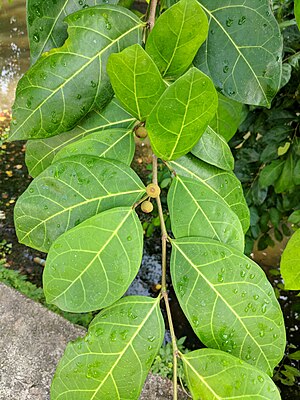Note: This is a project under development. The articles on this wiki are just being initiated and broadly incomplete. You can Help creating new pages.
Difference between revisions of "Ficus tinctoria - Goddumitle"
m (Arun93 moved page Ficus tinctoria - Sweet scented oleander to Ficus tinctoria - Goddumitle: Name corrected) |
(→External Links) |
||
| Line 87: | Line 87: | ||
[[Category:Herbs]] | [[Category:Herbs]] | ||
[[Category:Plants of western ghats]] | [[Category:Plants of western ghats]] | ||
| + | [[Category:Moraceae]] | ||
Revision as of 17:19, 23 May 2019
Goli, Ficus tinctoria is a small spreading fig tree with rough leaves. This tree usually grows as an epiphyte on other trees.
Contents
- 1 Uses
- 2 Parts Used
- 3 Chemical Composition
- 4 Common names
- 5 Properties
- 6 Habit
- 7 Identification
- 8 List of Ayurvedic medicine in which the herb is used
- 9 Where to get the saplings
- 10 Mode of Propagation
- 11 How to plant/cultivate
- 12 Commonly seen growing in areas
- 13 Photo Gallery
- 14 References
- 15 External Links
Uses
Parts Used
Chemical Composition
Common names
| Language | Common name |
|---|---|
| Kannada | aane gulaganji |
| Hindi | baragunci, barighumchi, barigumchi |
| Malayalam | manjadi |
| Tamil | aanaikundrimani, anai kundumani |
| Telugu | bandi gurivenda, bandi gurvina, bandigurivenda, bandiguruginja, enugaguruginji |
| Marathi | NA |
| Gujarathi | NA |
| Punjabi | NA |
| Kashmiri | NA |
| Sanskrit | kamboji, ksharaka, kucandanah,tamraka |
| English | Coralwood tree |
Properties
Reference: Dravya - Substance, Rasa - Taste, Guna - Qualities, Veerya - Potency, Vipaka - Post-digesion effect, Karma - Pharmacological activity, Prabhava - Therepeutics.
Dravya
Rasa
Tikta (Bitter)
Guna
Laghu (Light)
Veerya
Sheeta (cold)
Vipaka
Karma
Pitta
Prabhava
Habit
Identification
Leaf
| Kind | Shape | Feature |
|---|---|---|
| Simple | alternate | stipules lateral, to 1.5 cm, lanceolate; petiole 5-10 mm, slender, grooved above, scabrous; lamina 5-12 x 2-5.5 cm, elliptic-ovate or rhomboid, gibbous on one side, base acute or attenuate, apex acute or acuminate, margin entire, gibbous on one side, more or less scabrous, hispid above, coriaceous; 3-ribbed from base, lateral nerves 3-7 pairs, pinnate, prominent beneath, intercostae reticulate, prominent. |
Flower
| Type | Size | Color and composition | Stamen | More information |
|---|---|---|---|---|
| Unisexual | Syconia | 1 | axillary, usually paired or clustered, rarely solitary, globose; peduncle 1.5-10 mm, slender, scabrous, body scabrous; basal bracts 3, small, closed by several small apical scales; internal bristles minute, abundant; flowers of 4 kinds, male and gall flowers in same receptacle; female in separate; male flowers ostiolar, in 1-2 rows, sessile or pedicellate, oblong; tepals 3-6, free, 0.7-1 mm, white, scabrous, puberulous; stamen 1; filament 0.6 mm long; anther oblong, parallel, mucronate; pistillode present; female flowers sessile; tepals 4, oblong, free, white, scabrous, puberulous; ovary superior, sessile, 1 x 0.8 mm, obovoid-globose, white; style 2 mm, lateral; gall flowers sessile or pedicellate; tepals as in male flowers; ovary 0.5 mm across, globose or 2-lobed; style lateral, short tapering, tip thickened, brown. |
Fruit
| Type | Size | Mass | Appearance | Seeds | More information |
|---|---|---|---|---|---|
| Syconium | yellow when ripe; peduncle to 1.5 cm long; achene 1.5 x 1.2 mm, keeled or not. | {{{6}}} |
Other features
List of Ayurvedic medicine in which the herb is used
Where to get the saplings
Mode of Propagation
How to plant/cultivate
Season to grow
Soil type
Propagation
Commonly seen growing in areas
Photo Gallery
References
External Links
Categories:
- Herbs with common name in Kannada
- Herbs with common name in Hindi
- Herbs with common name in Malayalam
- Herbs with common name in Tamil
- Herbs with common name in Telugu
- Herbs with common name in Sanskrit
- Herbs with common name in English
- Habit - Small tree
- Index of Plants which can be propagated by Seeds
- Index of Plants which can be propagated by Cuttings
- Herbs that are commonly seen in the region of Tropical area
- Herbs
- Plants of western ghats
- Moraceae

